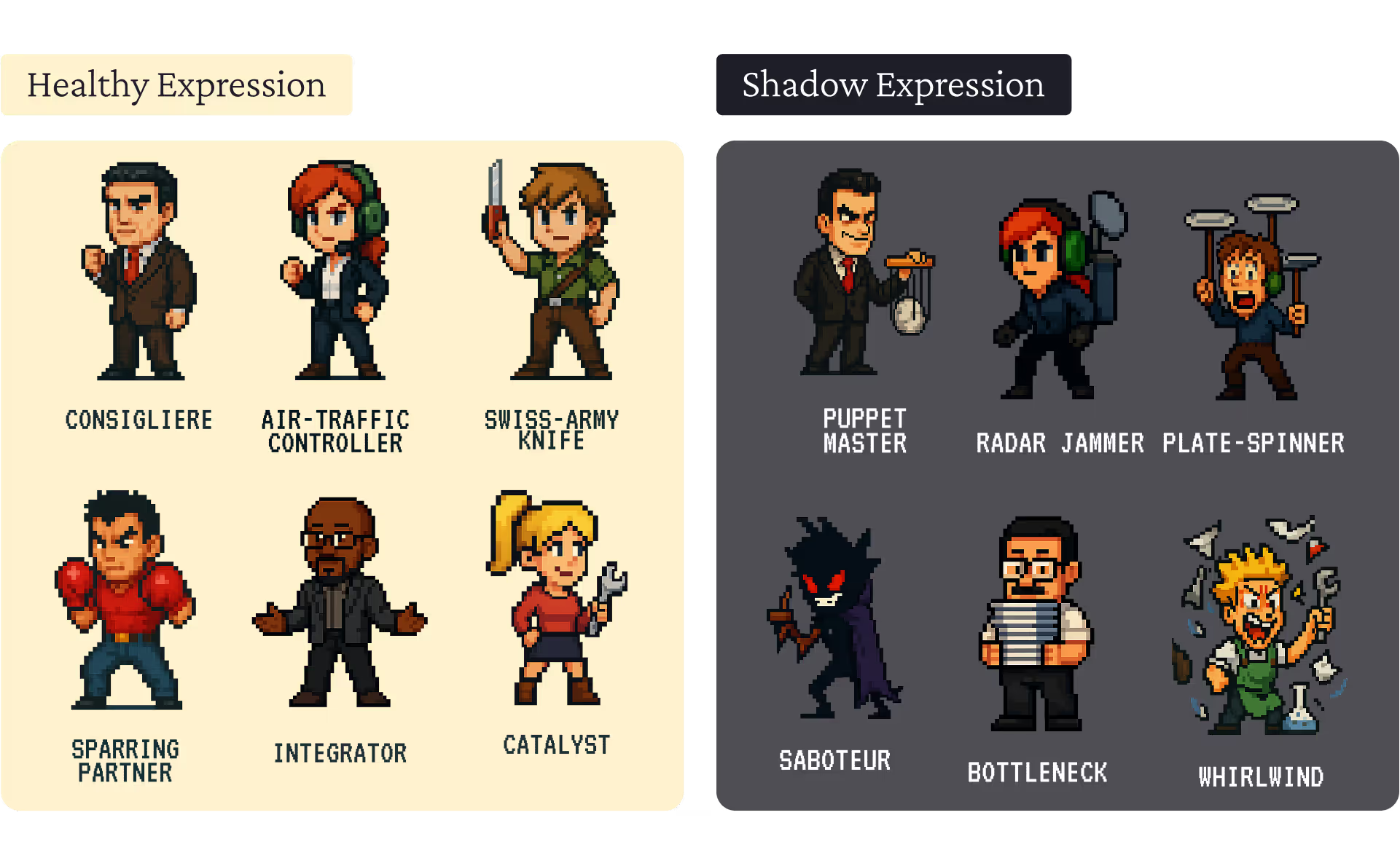I served as Chief of Staff to the CEO at Opendoor as we scaled from 200 to 800 employees in a year. Here’s an overview of the role, when and why the role is valuable, and how to make it a success for both the Chief of Staff and the executive.
This post includes 3 parts:
- Part 1: Overview of the Chief of Staff role
- ~Manage priorities
- ~Oversee staff/internal operations
- ~Spearhead special projects
- Part 2: FAQs for potential Chiefs of Staff
- Part 3: FAQs for executives considering hiring a Chief of Staff

Part 1: Overview of the Chief of Staff Role
What is a Chief of Staff?
A Chief of Staff is the right-hand person and force-multiplier to an executive, often the CEO. This can mean many things depending on the needs of the company and executive, and can change over time, but typically encompasses managing the executive’s priorities, overseeing staff/internal operations, and spearheading special projects.
Here are a few examples of what a Chief of Staff might work on:
- Manage priorities: do calendar audits, review and synthesize metrics/ initiatives to support company priority setting
- Oversee staff/internal operations: prepare agendas, take notes, and assign action items at weekly staff meetings, manage the OKR and annual planning processes, support with board meeting prep, create decision-making frameworks, manage All Hands programming
- Spearhead special projects: lead a metrics overhaul, do customer research on an adjacent business opportunity, run an acquisition process, lead the search for an executive hire
In addition, the Chief of Staff is often an advisor and confidant to the executive since he or she shares a similar purview to the executive, and doesn’t have their own agenda or separate team and goals like other executives do.
How does the Chief of Staff role vary by company?
The Chief of Staff role will vary based on company stage, company priorities, and the executive, resulting in no two roles that look exactly alike.
At an earlier stage company, a Chief of Staff may spend part of their time filling in gaps in the organization, such as working on partnerships when there is no business development team yet, or working on executive recruiting when there are high-priority hiring needs.
At a later stage company, the Chief of Staff may spend more time on internal comms, managing the staff meetings and priorities, and building decision-making frameworks, since larger organizations demand more time and attention on driving alignment.
No matter the stage of the company, a Chief of Staff will also often find themselves setting up or improving systems and processes, and once developed, keeping them at a steady state while moving on to the next set of systems or processes to improve. The Chief of Staff will likely prioritize upleveling areas of the business that are the most cross-functional, and thus where there isn’t naturally a clear owner. Additionally, areas where the executive needs to have a lot of direct input can be a good fit for a Chief of Staff, such as the executive’s monthly company update email or the company All Hands.
When is a company ready for a Chief of Staff?
A company is typically ready for a Chief of Staff when the company has reached product-market fit and is starting to scale. At this point in a company’s trajectory, internal operations and communications needs become urgent and often this is the time an executive team is just starting to come together. You’ll know its time for a Chief of Staff when an additional individual’s time is not better spent somewhere else in the business, e.g. building product or performing critical supporting roles.
Part 2: FAQs for Potential Chiefs of Staff

Should I take on a Chief of Staff position?
It depends on what you’re optimizing for, how the role is scoped, and who the executive is you’d be working for. There are pros and cons to the role to consider before making the leap.
Benefits:
- Unique perspective across the company: you’ll have a view across the entire company unlike any other role except your executive’s, and may include things like joining board meetings, executive staff meetings, and supporting the vision and strategy setting for the company
- Access to the executive team: you’ll help your executive manage their staff, so you’ll understand their priorities, working styles, strengths and weaknesses, and through this be able to learn from them
- Ability to learn about and flex across various functions: you will likely do things like communications, recruiting, and board preparation, perhaps for the first time
- Network: you’ll have more access to the network of your executive, including board members and their own personal network
- Credibility and opportunity: having the trust of your executive gives you credibility in the eyes of your company and their network, and if you do a good job in the role, can lead to opportunities both within the company and externally
Potential drawbacks:
- Opportunity cost: by choosing to enter the Chief of Staff role, you’re opting out of the learning and growth along the trajectory you’re currently on for the period of time you’re in the Chief of Staff role
- More isolated: moving from a traditional team setup to the Chief of Staff role means much less time with your peers and those you used to work with. Additionally, many Chiefs of Staff are the first ones to take on the role at their company, and therefore need to define for themselves who their mentors are and how they interface with the rest of the organization.
- Broad not deep: you’ll likely manage several projects at once, instead of going deep on one thing. One-off urgent tasks inevitably crop up.
If you do decide to move forward in pursuing a Chief of Staff role, the two most important things you can do when engaging with a company and executive on a Chief of Staff role are:
- Scope the role: ensure you’ll have impact by clearly defining what the role will entail. Review in detail what your priorities will be, how much time you’ll spend on each, and how you’ll work together on a daily basis. Discuss what success looks like in the role, and how you’ll measure it.
- Gauge fit: you’ll be working closely with this person on a daily basis. Make sure you trust and respect them, are able to communicate with them effectively, and enjoy working with them. Their world is about to become yours so you’ll want to make sure it’s a good fit.
A note on timing: Most Chiefs of Staff have 2–8 years of work experience when entering the role, often from generalist backgrounds. They have learned the basics of how companies operate, how to communicate, how to execute on projects with little oversight, and have developed some “executive presence” that allows them to stand in for their executive as needed. You’ll usually see more years of work experience among Chiefs of Staff at larger companies, just like you do in other roles.
What does success look like in the Chief of Staff role?
An excellent Chief of Staff transforms their executive into the best version of themselves.
- Manage your executive’s time closely to ensure it is spent on the top priorities for the company. It is your executive’s most scarce and critical resource. This could include weekly calendar audits and a daily standup to sync on priorities.
- Put into place and oversee operational procedures that help your executive better manage their meetings, team, and workload. Internal operations should be grounded in principles and utilize clear, consistent processes and practices. Checklists and templates for things that happen on a repeat basis are critical for establishing a repeatable, mistake-free way to run things, and can start to become the “playbook” by which the internal operations of the company are run.
- Provide leverage to your executive so that they can better understand the business, make decisions and manage their teams. This can come in the form of ad-hoc support or longer-term special projects. Here are a few examples:
- Metrics: Company metrics inevitably evolve over time, so check in here to start. Are these metrics reflective of the priorities of the business? On what cadence and in what setting are they reviewed by the company and by the executive team?
- Decision-making frameworks: Executives make dozens of decisions each week. You can help your executive make better decisions, more quickly, by creating frameworks and outlining possible scenarios for them. To do this, lay out the options or scenarios, and detail the pros/cons or trade-offs for each. Have your personal recommendation ready to share as well, but often a neutral framing is a good way to start.
- Customer research: “Secret shop” your company’s product and manage a regular customer interaction cadence to keep you executive closer to customer feedback.
- Culture: you can help your executive keep a pulse on company culture by gathering ad hoc feedback, e.g. asking “What did you think of this week’s All Hands meeting? What could we improve?”; it’s also useful to keep a pulse on what other companies are doing on the culture front, and implementing what you learn about that you like.
Finally, success in the Chief of Staff role requires trust, both between you and your executive, and you and the rest of the organization. The Chief of Staff is privy to sensitive information that most employees, including other executives, are not. It’s critical not to break that trust by sharing confidential information.
How should I prepare for a Chief of Staff interview?
The Chief of Staff role is largely about fit with (1) the role and (2) the executive. Make sure you understand the scope of the role and have spent time getting to know the executive before evaluating whether or not the opportunity is right for you.
In an interview setting, the executive also wants to get a sense for whether you’ll be a good fit for the role, both in your skills and attributes but also interpersonally. Here are a few questions they might ask:
- Why do you want to be a Chief of Staff? You might want to speak to what kind of impact you want to have on the organization, what you want to learn in the role, and how that might prepare you for what you want to do next
- How might you tackle X? You might get asked how you would approach a certain problem, or to give feedback on recent company communication. Additionally, you might get asked to take on project so that the executive can assess your work and get a feel for what it might be like to work together.
You’ll also want to ask some questions of the executive to make sure the role will be a fit for you. Here are a few suggestions:
- Why are you hiring a Chief of Staff? It can be helpful to understand the motivations behind the hire.
- What are your expectations from your Chief of Staff? How would you define the scope of the role? These questions will allow you to understand exactly what your executive wants support on. Expectation setting is a critical conversation to have, and will likely be something you’ll want to check in on on a consistent basis.
Got the job! How should I prepare to start?
The best place to reference when preparing to start is the scope of the role you interviewed for. The scope will vary based on your company and executive’s needs, and can change over time — most important is that it’s codified up front. When defining the scope of the Chief of Staff role with Eric Wu, CEO of Opendoor, we broke down responsibilities across 3 areas:
- Operations of the office of the CEO, e.g. managing Eric’s time allocation, weekly staff meeting, and quarterly/annual planning
- Internal and investor comms, e.g. overseeing All Hands, Eric’s weekly email to company, and board meeting prep
- Special projects, which included things like overhauling company metrics, incubating a new product line (which became Trade-Ins), and managing the acquisition of Open Listings
Like any new job, a good place to tactically get started is by preparing a 30–60–90 day plan based on the priorities of your executive. You’ll also want to define how you’ll work together, though this will likely evolve over time. Eric and I had a daily 10am standup that included his Executive Assistant where we’d review his calendar and the day’s key objectives for each of us, and a weekly 30 minute 1:1.
What should I do after the Chief of Staff role?
Most people see Chief of Staff roles as a 1–2 year tour of duty followed by a transition back into the organization. However, there have been excellent Chiefs of Staff who have stayed in the role for many years and play incredibly impactful roles, so that’s an option as well. Make sure you address timeline and what you might want to do next with your executive before kicking off in the role, and check in on this topic periodically. Since many Chiefs of Staff come from generalist backgrounds, their next role is likely a generalist role at a more senior level in the organization or working on a new business unit or product.
Part 3: FAQs for Executives
Should I hire a Chief of Staff?
There are good reasons to hire a Chief of Staff and bad reasons to hire a Chief of Staff.
Good reasons include:
- You want to get leverage on the things you do today that help you better understand the business, manage your team, and make decisions, and you’ve already leveraged your direct reports on these fronts but still have additional needs.
- Your company is scaling quickly and the organization needs to uplevel its operating procedures, including All Hands meetings, staff meetings, company-wide comms, board meetings, OKR processes.
- This likely isn’t sufficient as a reason on its own, but this role is often good for an up-and-coming employees who you want to groom for a more senior role at the company.
Bad reasons include:
- You’re exhausted and just want someone to take the reins.
- You aren’t able to hire for a particular executive role, and are hoping the Chief of Staff can be a bandaid here.
- The Executive Assistant you’re looking to hire wants a Chief of Staff title.
How is a Chief of Staff different than an Executive Assistant?
Executive Assistants largely focus on the logistics around the executive’s schedule and provide general assistance on tactical items such as travel arrangements. Hiring an Executive Assistant before a Chief of Staff can allow an executive to get immediate tactical support. Once an Executive Assistant is in place, the executive can better evaluate the need for a Chief of Staff. Some executives hire Chiefs of Staff and scope the role to include tasks which are typical of an Executive Assistant. I recommend against this, as the profile of the person who will join as a Chief of Staff role that includes assistant tasks will be different, and the executive may not get the leverage they need on more strategic projects.
Who should I hire for my Chief of Staff?
You will have most success by hiring someone who is a high horsepower, trustworthy, is a good communicator, has executive presence so they can interface well with external parties, at your board meeting, and with your executive team, and who is a fit with you personally.
You will likely have the option of hiring internally for the Chief of Staff role, or externally. If hiring externally, usually the reason to do this is if you want someone who has been a Chief of Staff before, or if there isn’t someone internally who would be a good fit. Otherwise, hiring internally has many benefits, including your ability to better assess them based on their history at the company, and their preexisting understanding of the business and culture which will help them hit the ground running much faster.
How should I run the interview process?
Like most interview processes, you’ll want to start by identifying what traits and skills you want to see in that person. Since each executive and company has slightly different needs, this may vary, but overall I’d test for the following:
- Raw horsepower and problem solving skills: you might ask the candidate to come up with a framework for making a decision, or how they’d prioritize resources among a few projects at the company (this works better when the candidate has company context).
- Communication skills: you could ask the candidate for feedback on a piece of internal comms, e.g. a memo to investors, a company-wide email, to test how insightful and savvy they are about communications.
- Ownership mentality: it’s important that your Chief of Staff have a strong ownership mentality, like that of a CEO, since you’ll want them to go the extra mile on noticing flaws in the customer experience, collecting and sharing feedback from employees, and being detail-oriented in how they manage their projects as an example for the rest of the organization
- Integrity: for internal candidates, you can talk to their managers. The best way to test external candidates for this is with references, both from the candidate and backchannel.
How should I make the most of working with a Chief of Staff?
Like any other direct report, alignment and accountability are critical. Create a role scope document that outlines the areas of responsibility, such as Internal Operations, Internal Comms and Special Projects, and establish quarterly goals within each of these buckets. Set expectations together about how much time is spent on each bucket, and on how you expect to receive updates. I used to send Eric a weekly update email with 3 categories — Completed, Upcoming/In Progress, and Blockers (otherwise known as the 3 P’s — Plans, Progress, Problems). We would then use our 1:1 time to discuss blockers and any other areas I needed him input on. We would also ensure feedback (both ways!) was part of our weekly 1:1s.
Additionally, you’ll need to share what you’re thinking about frequently and openly, so that your Chief of Staff has sufficient context to do their job well. This may be new and feel uncomfortable at first, but provided you have a trusting relationship, this will enable your Chief of Staff to be a useful sounding board.
—
That’s all for now! Let me know if you have feedback or questions @juliadewahl on Twitter. In the meantime, here are some resources for additional reading:
- Gatekeepers by Chris Whipple, a fantastic overview of the White House Chiefs of Staff
- LinkedIn Chief of Staff Brian Rumao’s blog post and video series
- Lightspeed partner Nakul Mandan’s interview with Gainsight’s CEO Nick Mehta and 3 of his Chiefs of Staff Tim Hoag, Nathan St. Martin, and Tyler Elkington
- First Round Review’s “Why you need 2 chiefs in the executive office”
- Comprehensive reading list on the Chief of Staff role from Richard McLean
Thanks to Chiefs of Staff Andrew Schulte (Opendoor), Anuj Abrol (Atrium), and Carly Emmer (Coinbase) for their feedback on this post.





.avif)
.avif)








